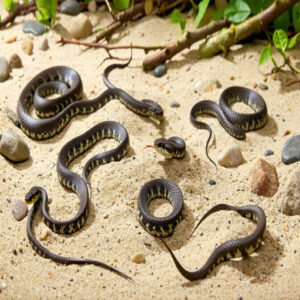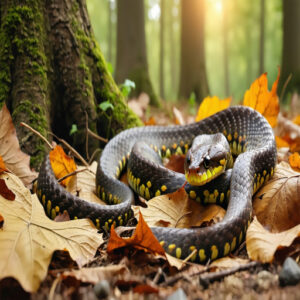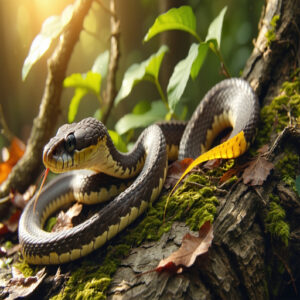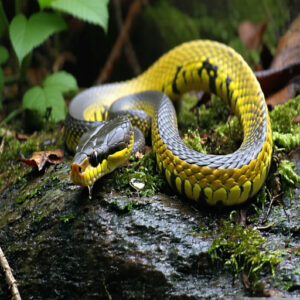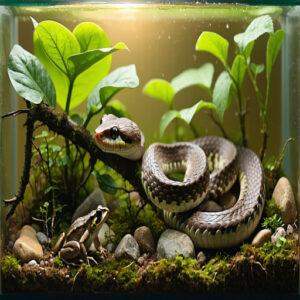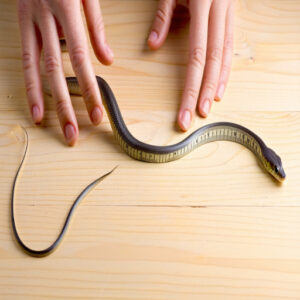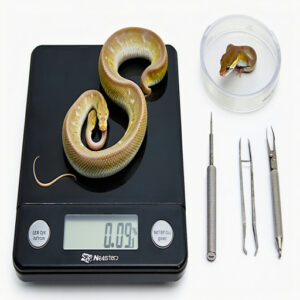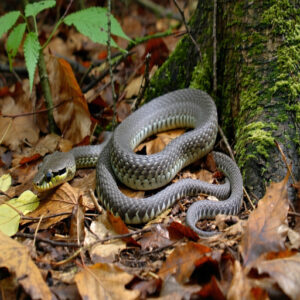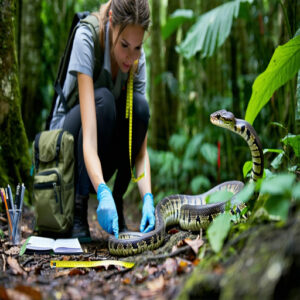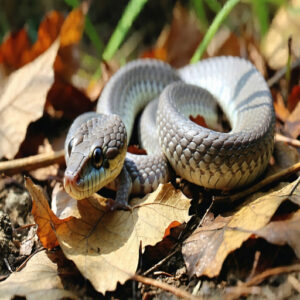This site is supported by our readers. We may earn a commission, at no cost to you, if you purchase through links.

Most are born between 7 and 12 inches long, similar to the length of a ruler, though some can be as small as 5 inches (imagine a large earthworm) or as long as 30 inches.
Weight varies too, from a lightweight 2 grams up to a sturdy 300 grams.
For instance, hatchling ball pythons are stocky but short, weighing about 50-60 grams.
Genetics, the mother’s health, and environmental factors play big roles in determining size.
Curious about how other fascinating species measure up?
Their size can reveal so much more.
Table Of Contents
- Key Takeaways
- Average Size of Newborn Snakes
- Copperhead Babies: a Closer Look
- Size Variations Among Different Snake Species
- Measuring Techniques for Baby Snakes
- Growth Patterns in Young Snakes
- Implications of Newborn Snake Size
- Frequently Asked Questions (FAQs)
- How Often Should I Feed My Baby Snake?
- How Long Does It Take for a Baby Snake to Become an Adult?
- Are Baby Snakes Dangerous?
- What Kind of Environment Should I Provide for My Baby Snake?
- Are There Any Special Considerations When Handling a Baby Snake?
- What is the size of a newborn snake?
- What does a newborn snake look like?
- What to do if you find a baby snake in your yard?
- Can a baby snake look like a worm?
- What to do if you see a baby snake in your house?
- Conclusion
Key Takeaways
- Baby snakes are usually 7-12 inches long at birth, but some can be as small as 5 inches or as large as 30 inches, depending on the species.
- Their weight ranges from 2 grams (lighter than a coin) to 300 grams, with genetics, environment, and the mother’s health playing a big role.
- Hatchlings like copperheads are venomous right away and use unique features, like a yellow-tipped tail, to attract prey.
- Baby snakes grow quickly, doubling their size within months, fueled by frequent meals, warm habitats, and their species-specific traits.
Average Size of Newborn Snakes
When baby snakes are born, they can range in length from as small as 5 inches to as long as 30 inches, depending on the species.
Their weight varies too, with factors like genetics and habitat playing a big role in determining their tiny starting size.
Length Range for Most Species
Newborn snakes are usually tiny, measuring between 7-12 inches long, but don’t let their small size fool you—they’re built for survival.
This range depends on factors like species, genetics, and environment. Understanding the average newborn snake size is essential for their care and handling.
Examples of species within this length range:
- Garter snakes: Notable for their slim build.
- Corn snakes: Loved for their colorful patterns.
- Rat snakes: Agile climbers.
- Milk snakes: Mimicry masters.
- Ball pythons: Short but sturdy hatchlings!
Weight Range for Newborns
In terms of snake birth weight, imagine holding something as light as a coin.
Neonates weigh mere grams, ranging from 2g to 300g, depending on species.
Understanding baby snake size is essential for their care and development, as seen in the link to baby snake size.
Here’s a quick look at the sizes of different snake species:
| Snake Species | Weight (Grams) | Size Comparison |
|---|---|---|
| Garter Snake | 2-5g | Paperclip-sized |
| Ball Python | 50-60g | Small plum |
| Green Anaconda | 200-300g | Small apple |
Baby snake scales hold nature’s tiniest secrets, including information about snake birth weight and the importance of understanding species-specific care.
Factors Affecting Newborn Size
Understanding what shapes baby snake size? Several factors play a role:
- Genetic influence: Parental genes, like dominant traits, set limits for baby snake size.
- Environmental factors: Nest temperature, food availability, and resources directly impact growth.
- Mother’s health: Healthier mothers often produce larger, stronger hatchlings.
- Clutch size: Smaller clutches usually result in larger newborn snakes due to fewer shared resources.
To learn more about the size of newborn snakes, visit information on baby snake sizes to understand their development better.
Comparison to Adult Snake Sizes
Baby snake size comparison highlights just how much they grow.
A copperhead’s newborn proportions (7-9 inches) resemble a small sneaker, while adults stretch to 2-3 feet, the size of running shoes.
Larger species, like anacondas, start longer than some adult snakes and grow to 30 feet—a skyscraper in snake size ratios.
Understanding snake size charts helps to visualize these dramatic growth patterns.
Growth patterns are truly mind-boggling!
Copperhead Babies: a Closer Look
When baby copperheads are born, they typically measure around 7 to 10 inches long, making them easy to miss in the wild.
You’ll notice their unique yellow-tipped tail, a feature they use to attract prey during their early, vulnerable stages.
Typical Size of Newborn Copperheads
How big are baby copperheads when they’re born?
These newborns typically measure 7-9 inches in length, fitting snugly into the average newborn snake length range.
Weighing just a few grams, their small newborn weight contrasts with the incredible punch their venom packs.
Don’t let their modest baby size fool you—copperhead growth happens fast, making them impressive hunters early on, with a significant venom impact.
Unique Yellow Tail Tip Feature
Copperhead newborns showcase a striking yellow tail tip—a brilliant example of tail feature evolution.
This distinctive mark functions like a baited hook, exploiting color adaptation strategies to attract prey. The yellow tip moves like a wriggling worm, intriguing small animals.
- Tail color patterns enhance predatory success.
- Ambush tactics paired with camouflage.
- Creative use of snake tail morphology.
- A clever lure born from nature’s tricks.
- Yellow tip function aids survival.
The combination of these elements demonstrates a highly effective strategy, showcasing the evolution of unique features for survival and hunting success.
Venom Capabilities at Birth
From the moment they’re born, newborn baby copperhead snakes are venomous and ready for action.
Their venom delivery system is fully functional, using tiny fangs to inject potent, deadly venom for hunting and self-defense. These venomous snake babies can immobilize prey with surprising efficiency, despite their small baby snake size.
Adding to their skill, a bright yellow tail lures unsuspecting prey, making snake bites even more effective. Research on snake venom components helps scientists understand the complex mechanisms behind their venom production.
While their toxic levels aren’t necessarily more dangerous than adults, their venom production kicks in early, allowing them to survive independently. No wonder folks often wonder, "Are baby snakes more venomous?
Growth Rate in Early Stages
Doubling their size within the first year, these baby copperheads grow fast thanks to hearty appetites and perfect conditions.
With each meal, their neonate progress speeds up, showcasing remarkable early growth.
- They prefer small prey like insects and tiny frogs, essential for newborn snake behavior.
- Warmer habitats boost their snake growth rate.
- Their rapid development helps with baby snake identification, which can be aided by remarkable early growth.
Size Variations Among Different Snake Species
You’ll be amazed how much baby snakes can vary in size depending on their species.
From tiny threadsnakes barely a few inches long to baby anacondas stretching over two feet, their differences are just as fascinating as their survival strategies.
Smallest Newborn Snake Species
Some of the smallest snakes had babies no bigger than a pencil, which poses survival challenges.
Snake hatchling size in these miniature reptiles poses challenges, like escaping predators and finding food.
These tiny species—hognose snakes, for instance—are born at just 5-9 inches long.
The study of smallest snake species helps us understand their unique characteristics.
- Their newborn habitats depend on camouflage.
- Eggs are surprisingly small.
- They rely on being tiny explorers to stay unseen.
Largest Newborn Snake Species
The largest newborn snakes, like newborn anacondas and python hatchlings, are nothing short of nature’s giants.
These massive offspring can stretch up to 30 inches long, setting snake size records from the start.
Compared to small wriggling hatchlings, these giant species’ baby snakes are born ready for survival, flaunting a body size that’s downright impressive for their day-old selves!
Egg-laying Vs. Live-bearing Size Differences
Regarding baby snake size, reproduction methods make a big difference.
Live-bearing species give their young a size advantage by nourishing them with placental connections and yolk sac reserves.
Egg-laying snakes, however, typically hatch smaller newborns, as their growth depends on:
- Egg size and nutrients available.
- Species-specific incubation periods.
- Genetics of the parent snake.
Environmental Influences on Newborn Size
Snake size at birth isn’t just genetics—it’s shaped by habitat effects, food availability, and water quality.
Temperature fluctuations from climate change can shrink or stretch the size of newborn snakes, while well-fed parents in lush environments lead to larger babies.
A nest in cozy soil boosts survival, but harsh conditions twist baby snake characteristics like a muddy footprint on a trail, influenced by habitat effects.
Measuring Techniques for Baby Snakes
When measuring baby snakes, you’ll need patience and the right tools to handle their tiny, wiggly bodies.
Simple techniques like using a ruler for length or a small scale for weight can provide accurate results without causing stress.
Standard Length Measurement Methods
Getting the right measurement baby snakes, like tiny hatchlings just learning the ropes, requires patience and the right tools.
Use a flexible tape measure and let the snake stretch naturally along it.
Calm movements help facilitate accurate Length Calculations.
Reliable Measurement Tools like soft tapes minimize stress while aiding Scale Analysis, Size Estimation, and Growth Tracking for accurate baby snake size records.
Weight Measurement Challenges
Measuring the weight of baby snakes isn’t as simple as tossing them on a scale.
These tiny, wriggling creatures often resist staying still, and their squirmy nature adds to the challenge.
Hatchling measurement tools, like precision digital scales, help calculate the weight of baby snakes in grams.
Yet, Snake scale analysis shows even minor movements can alter results substantially, which highlights the importance of accurate hatchling measurement tools.
Non-invasive Sizing Techniques
You don’t always need to get up close and personal to measure baby snakes.
Non-invasive sizing techniques include camera traps and thermal imaging, which provide valuable data without disturbing these tiny creatures.
Understanding baby snake size is essential for effective conservation and research efforts, and non-invasive sizing techniques help in this process.
Mark-recapture methods, remote sensing, and even footprint analysis offer unique ways to study snake length measurement and growth tracking.
These sneaky-smart methods give insights into baby snake size and behavior without them ever knowing we’re watching.
Importance of Accurate Measurements for Research
Getting the exact size of a newborn snake isn’t just for bragging rights—it’s critical for research.
Accurate tools and research methods help identify species, track snake development, and map habitats.
Imagine confusing a baby python with a harmless snakelet!
Scale accuracy guarantees data analysis stays sharp, supporting conservation efforts and shedding light on the surprisingly varied baby snakes size.
Growth Patterns in Young Snakes
You’ll be amazed at how quickly baby snakes start growing once they’re born, often doubling their length within months.
Factors like diet, habitat, and gender all shape how rapidly they reach important size milestones in their first year.
Initial Growth Spurt After Birth
In their first weeks, baby snakes experience a rapid growth spurt, surprising given their tiny start.
This boost in size and weight is essential for survival, quickly improving their chances against predators. A well-planned snake diet for growth is vital for supporting this early development.
- Size Doubling: Some baby snakes grow almost double their hatchling size.
- Increased Feeding: Frequent meals drive this growth.
- Shed Skin: Regular shedding accompanies early growth.
- Energy Surge: High activity supports development.
- Predator Evasion: Growth reduces vulnerability.
Factors Affecting Growth Rate
Baby snakes grow fast at first, but many factors decide how much.
Their diet, genetics, and the environment act as nature’s building blocks.
A warm, safe habitat boosts growth, while poor conditions stunt it.
Check out the growth drivers:
| Growth Factor | Impact on Snake Development |
|---|---|
| Nutrient Availability | Speeds up snake growth |
| Temperature | Supports metabolism |
| Genetic Influence | Governs baby snake size |
| Habitat Quality | Guarantees snake survival |
| Predator Threats | Affects snake growth rate |
Their future depends on these growth drivers and environment.
Size Milestones in First Year
Growth in a snake’s first year is fascinating.
Their baby snakes size surges quickly, influenced by diet, habitat, and survival needs.
Here’s how it unfolds:
- Hatchlings double in length within months, depending on food availability.
- Weight jumps as they master larger prey.
- Developmental stages reveal pattern maturity.
- Growth rate variations link directly to environmental influences like warmth.
Size-related survival truly starts here.
Differences Between Male and Female Growth
Not all baby snakes grow at the same pace—gender plays a big role.
Male development often outpaces females in certain species, with faster growth helping males reach sexual maturity sooner.
Female patterns tend to focus on robust size for reproduction.
Growth factors like diet and environment also impact these gender differences, shaping snake development into unique journeys for newborn snakes.
Implications of Newborn Snake Size
A newborn snake’s size plays a big role in its survival, affecting how well it can hide or hunt.
You might be surprised to learn that these tiny reptiles often face very different challenges, depending on their species and size.
Survival Advantages of Different Sizes
Being small gives baby snakes a serious edge, like snake camouflage in tight spaces, perfect for evading predators.
Yet, a larger size of newborn snake can mean fewer threats and better chances to find food, utilizing adaptive color for survival.
These survival tactics differ by species—whether using predation evasion or simply outgrowing rivals, every snake hatchling has its own size advantage.
Predator-prey Relationships for Newborns
Newborn snakes, despite their tiny size, are crafty survivors in a world full of predators like birds, cats, and larger snakes.
Their slim build helps with predator avoidance, blending into soil, leaves, or rocks effortlessly.
Some rely on camouflage as a survival tactic, while others use venom, if available, for defense.
Size impacts prey selection too—small snakes can only target tiny insects or amphibians.
The maternal care in maternal bonding behaviors of some species can substantially influence the survival rate of newborn snakes.
Human Encounters With Baby Snakes
Spotting newborn snakes during a walk can make you pause, especially with their tiny, worm-like size.
Always prioritize safety—don’t attempt handling them.
- Avoid baby snake handling; even small ones might be venomous.
- Learn venomous snake identification, like distinct patterns or head shapes.
- Stick to Snake Safety Tips, including maintaining distance.
- Remember snake bite prevention: wear boots, stay alert, and respect their space.
Frequently Asked Questions (FAQs)
How Often Should I Feed My Baby Snake?
Feed your baby snake every 5-7 days, depending on its age and species.
Start small—pinky mice or similar-sized prey work best.
Overfeeding can stress them, so keep an eye on their appetite and growth.
How Long Does It Take for a Baby Snake to Become an Adult?
Picture a baby snake, small and vulnerable, gradually shedding its juvenile charm.
It takes most species about 2-3 years to fully mature into adults, depending on food availability, habitat conditions, and their specific species traits.
Are Baby Snakes Dangerous?
Baby snakes can be dangerous, especially if they’re venomous.
Their small size doesn’t limit their ability to bite, and while they typically inject less venom than adults, their bites still pose serious risks.
Stay cautious!
What Kind of Environment Should I Provide for My Baby Snake?
Create a cozy habitat with warm hiding spots, a water bowl, and the right humidity.
Use a heat lamp for consistent warmth, avoid overcrowding, and remember—they love quiet spaces as much as you love yours!
Are There Any Special Considerations When Handling a Baby Snake?
Handle baby snakes gently, supporting their entire body.
Wash your hands before and after to avoid transferring scents or bacteria.
Be mindful of their quick movements and fragile tails—they’re tiny but surprisingly feisty explorers!
What is the size of a newborn snake?
Picture holding a pencil—that’s how small most baby snakes are when born, typically between 5 and 12 inches long.
Larger species, like green anacondas, can surprise you by being close to 30 inches!
What does a newborn snake look like?
A newborn snake looks like a tiny version of its adult self,
complete with scales, a distinct head, and open eyes.
It might even sport brighter colors or patterns, depending on the species.
What to do if you find a baby snake in your yard?
Finding a baby snake in your yard might feel like nature’s surprise party.
Keep calm—give it space, identify it from afar, and guarantee a safe relocation if needed.
Call local wildlife experts for assistance.
Can a baby snake look like a worm?
Yes, a baby snake can look like a worm.
Their small size, slender bodies, and subtle movements often resemble worms, but their scales and distinct head shape quickly reveal that they’re tiny reptiles, not worms.
What to do if you see a baby snake in your house?
If you spot a baby snake indoors, stay calm.
Gently guide it outside using a broom or container.
If it’s venomous or you’re unsure, call a professional.
Seal cracks to prevent future visits.
Conclusion
Did you know some baby snakes, like ball pythons, weigh up to 60 grams at birth, while others can be as light as 2 grams.
The size of newborn snakes varies greatly, with most measuring 7 to 12 inches long, but some species fall outside this range.
Factors like genetics, species, and environment influence their size.
Understanding how big baby snakes are when they’re born gives you insight into their survival, growth, and fascinating diversity across species.

